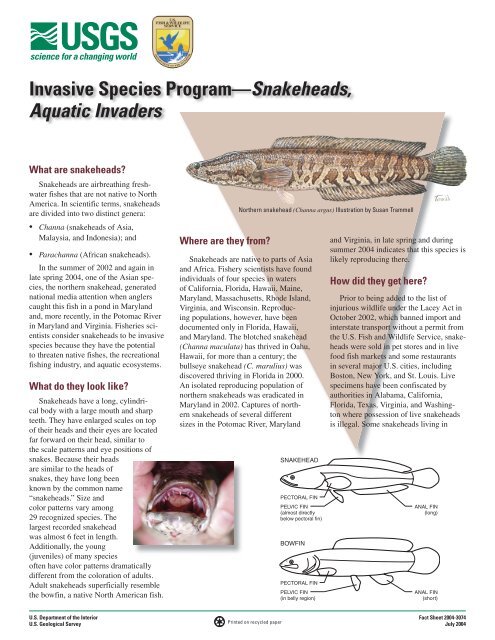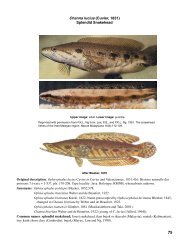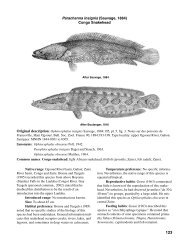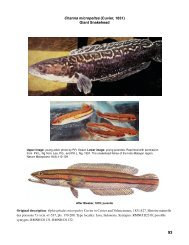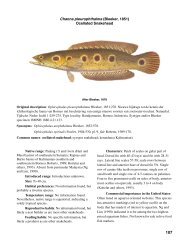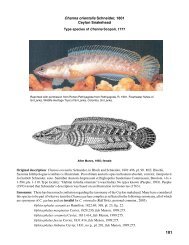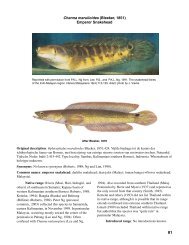Invasive Species ProgramâSnakeheads, Aquatic Invaders
Invasive Species ProgramâSnakeheads, Aquatic Invaders
Invasive Species ProgramâSnakeheads, Aquatic Invaders
Create successful ePaper yourself
Turn your PDF publications into a flip-book with our unique Google optimized e-Paper software.
<strong>Invasive</strong> <strong>Species</strong> Program—Snakeheads,<br />
<strong>Aquatic</strong> <strong>Invaders</strong><br />
What are snakeheads<br />
Snakeheads are airbreathing freshwater<br />
fishes that are not native to North<br />
America. In scientific terms, snakeheads<br />
are divided into two distinct genera:<br />
Northern snakehead (Channa argus) Illustration by Susan Trammell<br />
• Channa (snakeheads of Asia,<br />
Malaysia, and Indonesia); and<br />
• Parachanna (African snakeheads).<br />
In the summer of 2002 and again in<br />
late spring 2004, one of the Asian species,<br />
the northern snakehead, generated<br />
national media attention when anglers<br />
caught this fish in a pond in Maryland<br />
and, more recently, in the Potomac River<br />
in Maryland and Virginia. Fisheries scientists<br />
consider snakeheads to be invasive<br />
species because they have the potential<br />
to threaten native fishes, the recreational<br />
fishing industry, and aquatic ecosystems.<br />
What do they look like<br />
Snakeheads have a long, cylindrical<br />
body with a large mouth and sharp<br />
teeth. They have enlarged scales on top<br />
of their heads and their eyes are located<br />
far forward on their head, similar to<br />
the scale patterns and eye positions of<br />
snakes. Because their heads<br />
are similar to the heads of<br />
snakes, they have long been<br />
known by the common name<br />
“snakeheads.” Size and<br />
color patterns vary among<br />
29 recognized species. The<br />
largest recorded snakehead<br />
was almost 6 feet in length.<br />
Additionally, the young<br />
(juveniles) of many species<br />
often have color patterns dramatically<br />
different from the coloration of adults.<br />
Adult snakeheads superficially resemble<br />
the bowfin, a native North American fish.<br />
Where are they from<br />
Snakeheads are native to parts of Asia<br />
and Africa. Fishery scientists have found<br />
individuals of four species in waters<br />
of California, Florida, Hawaii, Maine,<br />
Maryland, Massachusetts, Rhode Island,<br />
Virginia, and Wisconsin. Reproducing<br />
populations, however, have been<br />
documented only in Florida, Hawaii,<br />
and Maryland. The blotched snakehead<br />
(Channa maculata) has thrived in Oahu,<br />
Hawaii, for more than a century; the<br />
bullseye snakehead (C. marulius) was<br />
discovered thriving in Florida in 2000.<br />
An isolated reproducing population of<br />
northern snakeheads was eradicated in<br />
Maryland in 2002. Captures of northern<br />
snakeheads of several different<br />
sizes in the Potomac River, Maryland<br />
SNAKEHEAD<br />
PECTORAL FIN<br />
PELVIC FIN<br />
(almost directly<br />
below pectoral fin)<br />
BOWFIN<br />
PECTORAL FIN<br />
PELVIC FIN<br />
(in belly region)<br />
and Virginia, in late spring and during<br />
summer 2004 indicates that this species is<br />
likely reproducing there.<br />
How did they get here<br />
Prior to being added to the list of<br />
injurious wildlife under the Lacey Act in<br />
October 2002, which banned import and<br />
interstate transport without a permit from<br />
the U.S. Fish and Wildlife Service, snakeheads<br />
were sold in pet stores and in live<br />
food fish markets and some restaurants<br />
in several major U.S. cities, including<br />
Boston, New York, and St. Louis. Live<br />
specimens have been confiscated by<br />
authorities in Alabama, California,<br />
Florida, Texas, Virginia, and Washington<br />
where possession of live snakeheads<br />
is illegal. Some snakeheads living in<br />
ANAL FIN<br />
(long)<br />
ANAL FIN<br />
(short)<br />
U.S. Department of the Interior<br />
U.S. Geological Survey<br />
Printed on recycled paper<br />
Fact Sheet 2004-3074<br />
July 2004
natural waters of the U.S. may have been<br />
released by aquarium hobbyists or those<br />
hoping to establish a local food resource.<br />
Also, some cultures practice “prayer<br />
animal release,” a faith-based activity in<br />
which individuals purchase, then release,<br />
an animal (fish, amphibian, reptile, or<br />
bird) to earn merits with a deity.<br />
What are the potential effects to<br />
our waters<br />
During all life stages, snakeheads<br />
compete with native species for food and<br />
habitat. As juveniles, they eat zooplankton,<br />
insect larvae, small crustaceans, and<br />
the young of other fishes. As adults, they<br />
become voracious predators, feeding on<br />
other fishes, crustaceans, frogs, small<br />
reptiles, and sometimes birds and small<br />
mammals. Should snakeheads become<br />
established in North American ecosystems,<br />
their predatory behavior could drastically<br />
disrupt food webs and ecological<br />
conditions, thus forever changing native<br />
aquatic systems by modifying the array<br />
of native species.<br />
An additional concern is the snakehead’s<br />
potential to transfer pathogens to<br />
native fishes, because snakeheads can<br />
carry diseases and parasites that have the<br />
potential to be harmful. Fishery scientists<br />
need to study this potential to determine<br />
if diseases and parasites can be transferred<br />
to North American species.<br />
Have snakeheads been<br />
introduced to places other than<br />
the United States<br />
Northern snakeheads were purposefully<br />
introduced and established into<br />
Japan in the early 1900s. They were<br />
introduced into parts of the former Soviet<br />
Union (Kazakhstan, Uzbekistan, Turkmenistan)<br />
when accidentally mixed with<br />
shipments of imported Asian carps. This<br />
fish also became established in Russia<br />
for a short time in the 1950s and was<br />
successfully introduced into Czechoslovakia.<br />
The blotched snakehead was successfully<br />
introduced into the Philippines<br />
and into Madagascar where it is now<br />
a major threat to many of the endemic<br />
cichlid fishes of that island nation.<br />
The chevron snakehead (Channa striata)<br />
was successfully introduced into the<br />
Philippines, is reported to be established<br />
in other Pacific islands, and is being<br />
cultured in Hawaii.<br />
Do snakeheads “walk”<br />
Although claims of their mobility have<br />
been greatly exaggerated, several species<br />
of snakeheads are able to wriggle overland<br />
from one body of water to another,<br />
particularly if the ground is wet. They do<br />
this by flexing their body and pushing<br />
with their tail, while using their broad<br />
pectoral fins to stabilize their head. It is<br />
unknown how far they can travel on land.<br />
This crawling ability is reduced in larger<br />
species of snakeheads as they reach adulthood.<br />
The introduced blotched snakehead<br />
in Madagascar is known to crawl<br />
onshore, allow its body to be covered<br />
with ants, then return to the water where<br />
the ants are dislodged and subsequently<br />
eaten by the fish.<br />
How many eggs do snakeheads lay<br />
A mature northern snakehead female<br />
can carry as many as 50,000 eggs,<br />
although some will not develop and<br />
others will be eaten by insects and small<br />
fishes following fertilization. Depending<br />
on water temperature, eggs can hatch in<br />
about 24-48 hours. When the fry hatch,<br />
they remain clustered at the surface of the<br />
nest until their fins develop. At that time,<br />
the young (early juveniles) begin swimming<br />
by diving down into the center of<br />
the nest, then rising back to the surface.<br />
Early juveniles remain in the nest for<br />
3-4 weeks, schooling, and being guarded<br />
by one or both parents. All species of<br />
snakeheads guard their eggs and young, a<br />
behavior that is rare in our native fishes.<br />
Juvenile snakeheads (fry) cluster at the<br />
surface of their “nest,” a column of water<br />
cleared from vegetation in 2-3 feet of water.<br />
Their parents will aggressively guard their<br />
nest for 3-4 weeks while the fry develop their<br />
fins, learn to school, and are ready to fend for<br />
themselves.
What are the major concerns about snakeheads<br />
• They are very predatory and could alter conditions in our aquatic<br />
ecosystems.<br />
• They are airbreathers and several species are capable of overland<br />
migration during some part of their life history.<br />
• They are very aggressive in their efforts to protect their young.<br />
• Some snakehead species have a very large potential range in the U.S.<br />
A recent comprehensive assessment concluded that when these factors<br />
are combined, snakeheads pose a significant threat to fish and wildlife<br />
resources of the United States.<br />
The reproductive behavior of snakeheads<br />
is quite interesting. Most, perhaps<br />
all, are nest builders. The northern<br />
snakehead, for example, builds its nest<br />
in shallow water by clearing an area of<br />
vegetation. This results in a cylindrical<br />
column of water devoid of most vegetation.<br />
Nests are about 2-3 feet deep and<br />
about 3 feet in diameter.<br />
A few species of snakeheads are<br />
mouthbrooders; that is, one of the<br />
parents will carry fertilized eggs in its<br />
mouth cavity. When the fry hatch, they<br />
are retained in the mouth until their fins<br />
develop to the point the young can swim.<br />
Even after the young leave the mouth of<br />
the adult, the parents continue to guard<br />
the young fish until they are able to fend<br />
for themselves.<br />
What eats snakeheads<br />
Although little information exists in<br />
the scientific literature regarding predation<br />
on snakeheads, juveniles would be<br />
the most vulnerable to predation by other<br />
predatory fishes and some wading birds<br />
once they leave the nest and their guarding<br />
parents. In U.S. waters where snakeheads<br />
have become established, the most<br />
likely predatory fishes on juveniles would<br />
be gars, larger sunfishes, bass, perch, and<br />
pike. Because most native fishes could<br />
not eat the larger species of adult snakeheads,<br />
these snakeheads could become<br />
the top predators within the freshwater<br />
fish community.<br />
Humans also eat snakeheads. Within<br />
their native ranges and places where they<br />
have been introduced, some species are<br />
considered a delicacy. Several species<br />
are caught in the wild for food, whereas<br />
others are cultured.<br />
Where do snakeheads live<br />
Snakeheads are freshwater fishes<br />
with little, if any, tolerance for saltwater.<br />
Within their native and introduced ranges,<br />
they live in small and large streams,<br />
canals, rivers, ponds, reservoirs, and<br />
lakes. Many species can tolerate a wide<br />
range of pH, and one species living in<br />
Malaysia and parts of Indonesia prefers<br />
highly acid waters (pH 2.8-3.8). The<br />
northern snakehead and several other<br />
species prefer to live in somewhat dense<br />
aquatic vegetation where they feed and<br />
reproduce.<br />
Can snakeheads harm humans<br />
Most snakeheads will avoid contact<br />
with humans. However, when guarding<br />
their eggs or young, they can become<br />
aggressive if approached. One species,<br />
the giant snakehead (Channa micropeltes)<br />
native to southeastern Asia, has been<br />
reported to be aggressive toward humans<br />
who got too close to their nest. Other<br />
snakeheads are not as aggressive toward<br />
humans.<br />
What is the Federal Government<br />
doing about snakeheads<br />
Two agencies within the Department<br />
of the Interior (DOI) are responsible for<br />
researching and regulating snakeheads.<br />
The U.S. Geological Survey (USGS;<br />
http://www.usgs.gov) is a research arm<br />
of DOI, and USGS scientists conducted<br />
extensive, worldwide research on snakeheads<br />
that provided a basis for regulating<br />
their importation and interstate transport<br />
in the U.S. Funding for that research was<br />
sponsored through a grant from another<br />
DOI agency, the U.S. Fish and Wildlife<br />
Service (FWS; http://www.fws.gov),<br />
which is responsible for fisheries management,<br />
regulations, law enforcement,<br />
and education. The mission of the FWS is<br />
to work with others to conserve, protect,<br />
and enhance fish, wildlife, and plants for<br />
the continued benefit of the American<br />
people.<br />
On October 4, 2002, the FWS added<br />
the snakehead family of fishes (Channidae)<br />
to the list of injurious wildlife under<br />
the Lacey Act. This includes all currently<br />
recognized species, and any new species<br />
that may be described within that family<br />
in the future. By taking this action, snakehead<br />
fishes can no longer be imported<br />
into the U.S. or transported across state<br />
lines without a permit. Permits for interstate<br />
transportation and importation into<br />
the U.S. can be obtained by calling the<br />
U.S. Fish and Wildlife Service Division<br />
What should be done with a captured snakehead<br />
• Do not release the fish or throw it up on the bank (it could wriggle<br />
back into the water). Remember, this fish is an airbreather and can live<br />
a long time out of water.<br />
• Kill the fish by freezing it or putting it on ice for an extended length<br />
of time.<br />
• Photograph the fish if you have access to a camera so the species of<br />
snakehead fish can be positively identified.<br />
• Contact your nearest fish and game agency or the U.S. Fish and Wildlife<br />
Service (703-358-2148) as soon as possible. Keeping data on the<br />
size, number, and location of where snakeheads are caught or seen is<br />
vital to controlling this invasive fish.
of Management Authority at 1-800-358-<br />
2104. Such permits, however, will only<br />
be issued for specific uses, such as medical<br />
or scientific research and education.<br />
This injurious wildlife listing is based<br />
upon a thorough review of the scientific<br />
data on snakehead fishes and a risk<br />
assessment that was prepared for the<br />
FWS by the USGS. The FWS determined<br />
that regulation of all snakehead species<br />
is necessary to protect wildlife from the<br />
purposeful or accidental introduction of<br />
snakeheads into the ecosystems of the<br />
United States.<br />
Can aquarium hobbyists still<br />
possess snakeheads as pets<br />
As mentioned previously, importation<br />
of live snakeheads and their interstate<br />
transport is prohibited. Many states<br />
prohibit possession of snakeheads, and<br />
several of those states have done so for<br />
decades. Aquarists can obtain information<br />
about regulations concerning<br />
possession of live snakeheads and other<br />
prohibited fishes by contacting their state<br />
fish and game agency. Transporting live<br />
snakeheads across a state line for any<br />
purpose, however, is a Federal offense<br />
under the Lacey Act, even between two<br />
states that allow possession of live snakeheads.<br />
Can snakeheads still be<br />
purchased for food purposes<br />
Dead snakeheads––on ice or<br />
frozen––can be imported for food<br />
purposes to any state except those where<br />
importation or possession of dead snakeheads<br />
is illegal. Live snakeheads of one<br />
species being cultured in Hawaii, but not<br />
exported to the mainland of the U.S.,<br />
are available in one market in Honolulu.<br />
Hawaii regulations require that all fish<br />
must be killed and their gills removed<br />
before the purchaser leaves the store.<br />
What is an invasive species and why should the<br />
American public be concerned<br />
For More Information,<br />
Contact:<br />
U.S. Fish and Wildlife Service<br />
Division of Environmental Quality<br />
Branch of <strong>Invasive</strong> <strong>Species</strong><br />
4401 N. Fairfax Drive,<br />
Suite 840<br />
Arlington, VA 22203<br />
(703) 358-2148<br />
http://contaminants.fws.gov/<br />
Issues/<strong>Invasive</strong><strong>Species</strong>.cfm<br />
(800) 344-WILD (800-344-9453)<br />
http://www.fws.gov<br />
Toll-free Hotline: 1-877-STOP-ANS<br />
http://www.protectyourwaters.net<br />
U.S. Geological Survey<br />
Southeast Ecological Science Center<br />
7920 NW 71st Street<br />
Gainesville, Florida 32653<br />
1352-378-8181<br />
http://fl.biology.usgs.gov<br />
An invasive species is an<br />
introduced, nonnative organism<br />
(disease, parasite, plant, or<br />
animal) that begins to spread<br />
or expand its range from the<br />
site of its original introduction<br />
and has the potential to cause<br />
harm to the environment, the<br />
economy, or to human health.<br />
A few well-known examples<br />
include the unintentional<br />
introduction of the West Nile<br />
virus, chestnut blight, the South<br />
American fireant in the southeastern<br />
states, zebra mussels,<br />
and lamprey eels in the Great<br />
Lakes, in addition to the intentional<br />
introductions of salt<br />
cedar (Tamarisk) in the southwest,<br />
kudzu vine in the southeast,<br />
house sparrows, starlings,<br />
and nutria in Louisiana and<br />
Maryland.<br />
Although the U.S. depends<br />
on many intentionally introduced<br />
nonnative plants and<br />
animals for our food supply,<br />
most are “domesticated” to<br />
be noninvasive (the introduction<br />
of potatoes and cattle, for<br />
example). In the past century,<br />
however, an increasing number<br />
of exotic plants and animals<br />
have been brought to the U.S.<br />
for other reasons. Many invasives<br />
have been unintentionally<br />
introduced as “hitchhikers”<br />
with imported species of plants,<br />
some animals have escaped<br />
or have been purposefully<br />
released, and many are now<br />
environmental and economic<br />
threats. A study conducted at<br />
Cornell University estimated<br />
the annual environmental and<br />
economic costs due to invasive<br />
species of plants and animals at<br />
$137 billion.*<br />
*Source: Pimentel, D., Lach, L., Zuninga, R.,<br />
and Morrison, D., 2000, Environmental and<br />
economic costs of nonindigenous species in the<br />
United States: Bioscience: v. 50, p. 53-65.<br />
The following report provides<br />
additional information on snakeheads<br />
and is available in HTML<br />
and downloadable pdf:<br />
Courtenay, W.R., Jr., and<br />
Williams, J.D. 2004. Snakeheads<br />
(Pisces, Channidae)––<br />
A Biological Synopsis and Risk<br />
Assessment: USGS Circular<br />
1251, 143 p.<br />
http://fl.biology.usgs.gov/<br />
Snakehead_circ_1251/index.html<br />
An informative and continually<br />
updated website database on<br />
nonindigenous plants and animals<br />
in the U.S. can be found at:<br />
http://nas.er.usgs.gov/<br />
and on the Northern Snakehead at:<br />
http://nas.er.usgs.gov/queries/FactSheet.aspx<br />
<strong>Species</strong>ID=2265.<br />
Updated July 2010


